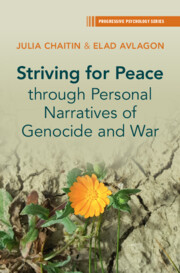1278 results
Explaining peace during long and rapid power shifts: A theory of grand bargains
-
- Journal:
- British Journal of Political Science / Volume 55 / 2025
- Published online by Cambridge University Press:
- 24 March 2025, e47
-
- Article
-
- You have access
- Open access
- HTML
- Export citation
19 - The Military Papacy
- from Part IV - Theopolitics and Religious Diplomacy
-
-
- Book:
- The Cambridge History of the Papacy
- Published online:
- 28 February 2025
- Print publication:
- 20 March 2025, pp 499-518
-
- Chapter
- Export citation
The Legacy of the Second Sino-Japanese War in the People's Republic of China: Mapping the Official Discourses of Memory
-
- Journal:
- Asia-Pacific Journal / Volume 20 / Issue 11 / June 2022
- Published online by Cambridge University Press:
- 14 March 2025, e4
-
- Article
- Export citation
Depictions of The Bomb and Nuclear Apocalypse in Japanese Anime
-
- Journal:
- Asia-Pacific Journal / Volume 19 / Issue 15 / August 2021
- Published online by Cambridge University Press:
- 14 March 2025, e2
-
- Article
- Export citation
1 - Avoiding War
- from Part I - Imperial Warfare
-
- Book:
- Seditious Spaces
- Published online:
- 06 March 2025
- Print publication:
- 13 March 2025, pp 23-46
-
- Chapter
- Export citation
15 - Globalizing European Military History
-
-
- Book:
- Globalizing Europe
- Published online:
- 06 March 2025
- Print publication:
- 13 March 2025, pp 239-259
-
- Chapter
- Export citation
Through the Dark Matter: Exploring Donbas Identity in Times of Peace and War
-
- Journal:
- Nationalities Papers , FirstView
- Published online by Cambridge University Press:
- 28 February 2025, pp. 1-18
-
- Article
-
- You have access
- Open access
- HTML
- Export citation
Military chaplains and equivalent religious personnel under international humanitarian law
-
- Journal:
- International Review of the Red Cross , First View
- Published online by Cambridge University Press:
- 27 February 2025, pp. 1-51
-
- Article
-
- You have access
- Open access
- HTML
- Export citation

Striving for Peace through Personal Narratives of Genocide and War
-
- Published online:
- 22 February 2025
- Print publication:
- 13 February 2025
Chapter 10 - Personal Narratives of Genocide and Intractable War
- from Part III - Suggestions for Further Research and Peace Work on the Ground
-
- Book:
- Striving for Peace through Personal Narratives of Genocide and War
- Published online:
- 22 February 2025
- Print publication:
- 13 February 2025, pp 166-176
-
- Chapter
- Export citation
6 - Metaphor
-
- Book:
- Language, Image, Gesture
- Published online:
- 08 January 2025
- Print publication:
- 13 February 2025, pp 141-174
-
- Chapter
- Export citation
Chapter 4 - Conceptualizations of Positive Peace and Reconciliation
- from Part I - Theoretical Background of the Book
-
- Book:
- Striving for Peace through Personal Narratives of Genocide and War
- Published online:
- 22 February 2025
- Print publication:
- 13 February 2025, pp 60-79
-
- Chapter
- Export citation
Chapter 3 - Coping, or Not, with Genocide and War
- from Part I - Theoretical Background of the Book
-
- Book:
- Striving for Peace through Personal Narratives of Genocide and War
- Published online:
- 22 February 2025
- Print publication:
- 13 February 2025, pp 41-59
-
- Chapter
- Export citation
Chapter 5 - Personal Narratives of Genocide and War and Their Connections to Peacebuilding or Peace Obstruction
- from Part I - Theoretical Background of the Book
-
- Book:
- Striving for Peace through Personal Narratives of Genocide and War
- Published online:
- 22 February 2025
- Print publication:
- 13 February 2025, pp 80-86
-
- Chapter
- Export citation
1 - Dar es Salaam
-
- Book:
- New Sudans
- Published online:
- 06 February 2025
- Print publication:
- 13 February 2025, pp 29-57
-
- Chapter
- Export citation
Chapter 9 - Personal Narratives of Genocide and Intractable War
- from Part III - Suggestions for Further Research and Peace Work on the Ground
-
- Book:
- Striving for Peace through Personal Narratives of Genocide and War
- Published online:
- 22 February 2025
- Print publication:
- 13 February 2025, pp 157-165
-
- Chapter
- Export citation
Conclusion
-
- Book:
- New Sudans
- Published online:
- 06 February 2025
- Print publication:
- 13 February 2025, pp 305-309
-
- Chapter
- Export citation
5 - Intellectual Work and Political Thought on the Peripheries
-
- Book:
- New Sudans
- Published online:
- 06 February 2025
- Print publication:
- 13 February 2025, pp 178-229
-
- Chapter
- Export citation
7 - Nazi Berlin
-
- Book:
- Berlin
- Published online:
- 13 February 2025
- Print publication:
- 30 January 2025, pp 134-160
-
- Chapter
- Export citation
1 - The Imperial State
- from I - 1750–1819: The Ends of the Ancien Régime
-
- Book:
- Modern Britain, 1750 to the Present
- Published online:
- 14 January 2025
- Print publication:
- 30 January 2025, pp 3-39
-
- Chapter
- Export citation


